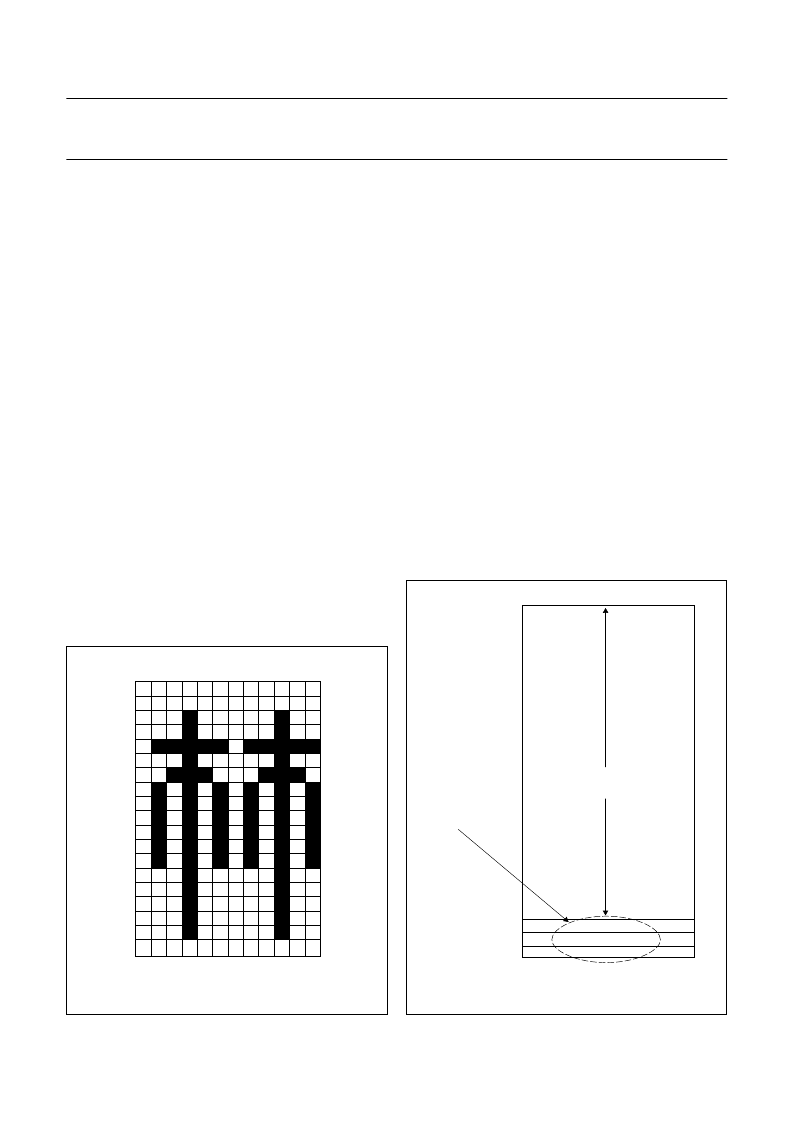- 您現(xiàn)在的位置:買賣IC網(wǎng) > PDF目錄382378 > PCA8514P (NXP Semiconductors N.V.) Stand-alone OSD PDF資料下載
參數(shù)資料
| 型號: | PCA8514P |
| 廠商: | NXP Semiconductors N.V. |
| 英文描述: | Stand-alone OSD |
| 中文描述: | 單機(jī)OSD |
| 文件頁數(shù): | 9/64頁 |
| 文件大?。?/td> | 322K |
| 代理商: | PCA8514P |
第1頁第2頁第3頁第4頁第5頁第6頁第7頁第8頁當(dāng)前第9頁第10頁第11頁第12頁第13頁第14頁第15頁第16頁第17頁第18頁第19頁第20頁第21頁第22頁第23頁第24頁第25頁第26頁第27頁第28頁第29頁第30頁第31頁第32頁第33頁第34頁第35頁第36頁第37頁第38頁第39頁第40頁第41頁第42頁第43頁第44頁第45頁第46頁第47頁第48頁第49頁第50頁第51頁第52頁第53頁第54頁第55頁第56頁第57頁第58頁第59頁第60頁第61頁第62頁第63頁第64頁

1995 Nov 27
9
Philips Semiconductors
Product specification
Stand-alone OSD
PCA8514
7
CHARACTER FONTS
128 character fonts may be held in ROM; 125 customer
selected fonts and three reserved character font codes.
Customer selected fonts are mask programmable. Each
character font is stored in a 12
×
19 dot matrix, as shown
in Fig.5. Elements in Rows 1 to 18 can be selected as
visible dots on the screen; Row 0 is used only for the
combination of two characters in a vertical direction, when
the North-West shadowing mode is selected (see
Sections 9.9 and 10.2). Extremely high resolution can be
achieved by having no spacing between characters on the
same line and by programming the inter-line spacing to
zero. The 12
×
18 dot matrix is suitable for the display of
semigraphic patterns, Kanji, Hiragana, Katagana or even
Chinese characters.
7.1
Character font address map
Figure 6 shows the character font address map in ROM
and RAM. Addresses 7FH and 7EH hold the reserved
codes for space and carriage return functions respectively;
address 7DH is reserved for testing purposes and
addresses (00H to 7CH) contain the character font codes.
7.2
Character font ROM
ROM is divided into two parts: ROM1 and ROM2. The
organization of the bit patterns stored in ROM1 and ROM2
is shown in Fig.7.
The file format to submit to Philips for customized
character sets is also shown in Fig.7. The following points
should be noted:
1.
Row 0 of each font is reserved for vertical combination
of two fonts.
2.
When two font cells are combined in a vertical
direction Row 0 of the lower font must contain the
same bit pattern as held in Row 18 of the character
above it.
3.
Binary 1 denotes visual dots; binary 0 denotes a blank
space.
4.
ROM1 and ROM2 data files are in INTEL hex format
on a byte basis. Each byte is structured High nibble
followed by Low nibble.
5.
The remaining unused 16 bytes (one character font) in
ROM1/ROM2 must be filled with FFH.
6.
CS denotes Checksum.
A software package (OSDGEM) that assists in the design
of character fonts on-screen and that also automatically
generates the bit pattern HEX files, is available on request.
The package is run under the MS-DOS environment for
IBM compatible PCs.
Fig.5 Character dot matrix organization.
0
1
2
3
4
5
6
7
8
9
10
11
12
13
14
15
16
17
18
0
1
2
3
4
5
6
7
8
9
10
11
MLC350
Fig.6 ROM address map.
0
125 (7DH)
126 (7EH)
127 (7FH)
Mask Programmable Font
Carriage return code
Space code
reserved code
MGC948
Test code
124 (7CH)
相關(guān)PDF資料 |
PDF描述 |
|---|---|
| PCA8514T | Stand-alone OSD |
| PCA8515 | Stand-alone OSD |
| PCA8515P | Stand-alone OSD |
| PCA8515T | Stand-alone OSD |
| PCA8516T | Stand-alone OSD |
相關(guān)代理商/技術(shù)參數(shù) |
參數(shù)描述 |
|---|---|
| PCA8514T | 制造商:PHILIPS 制造商全稱:NXP Semiconductors 功能描述:Stand-alone OSD |
| PCA8515 | 制造商:PHILIPS 制造商全稱:NXP Semiconductors 功能描述:Stand-alone OSD |
| PCA8515P | 制造商:PHILIPS 制造商全稱:NXP Semiconductors 功能描述:Stand-alone OSD |
| PCA8515T | 制造商:PHILIPS 制造商全稱:NXP Semiconductors 功能描述:Stand-alone OSD |
| PCA8515T/009 | 制造商:NXP Semiconductors 功能描述:ON-SCREEN DISPLAY IC, PDSO24 |
發(fā)布緊急采購,3分鐘左右您將得到回復(fù)。